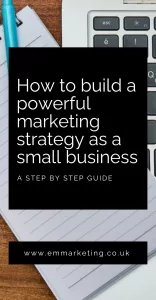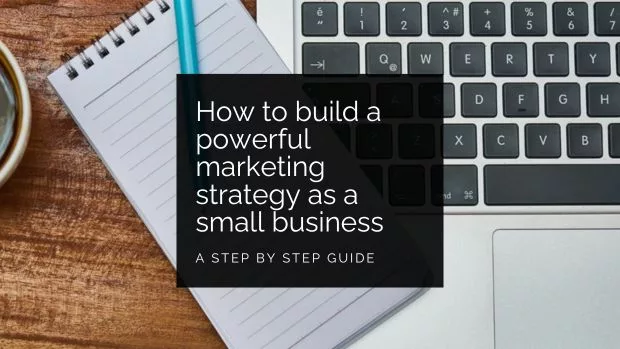Table of Contents
Introduction
As a small business owner, developing a marketing strategy is crucial to building brand awareness, trust, and customer loyalty and ultimately growing your business. However, many small businesses associate the term “strategy” with large companies that have big budgets, but in simple terms, a marketing strategy defines the overarching long-term plan for achieving your goals. The next step is the marketing plan, which addresses how you will achieve those goals in detail. The strategy provides the direction and high-level objectives, while the plan offers the roadmap to achieve those objectives. For small businesses, I find it works well to combine the two, as you will see below.
However, with so many marketing options out there and often limited resources and budgets, knowing where to begin can be a challenge.
Let’s first explore the strategy and break down the essentials of building a powerful marketing strategy as a small business.
Define your business goals
First, it’s important to identify your business goals because they will guide the marketing decisions you make. Ask yourself what you are trying to achieve through your marketing.
Are you looking to build brand awareness, attract new clients, retain existing ones, or do you have a new service to launch?
List all your goals and decide how to measure your progress for each. If your list is long and your resources are limited, you may need to prioritise your goals and work through them in priority order.
Identify your target audience
You can’t market effectively without understanding who you’re marketing to. Knowing who your target audience is, what their needs and values are, and where and how they find the services they need will help you to choose the right marketing channels and create messages that speak directly to your audience.
Develop your brand identity
A strong brand identity will help your business stand out from the crowd. When most people hear the phrase brand identity, they assume that it just means their logo, but brand identity goes much deeper than that. Map out your brand mission and values, your brand voice, your key brand messages, and what sets you apart from your competitors. Use your logo to create a strong brand look and feel you can use across your marketing. Identifying these areas upfront will ensure consistency in your marketing going forward.
Choose your marketing channels
As a small business, trying to be everywhere is unrealistic. Equally, not all marketing channels will be right for your business. So focus on the channels that best align with your goals and target audience. Some channels to consider are:
- Content marketing: engage and retain your audience by creating videos, blogs, and podcasts to drive traffic to your website.
- Email marketing: write to your audience using welcome emails, regular newsletters, promotional emails, to name but a few, to drive traffic to your website.
- Social media marketing: use social media platforms to promote your brand, engage with your customers, and drive website traffic.
- SEO (search engine optimisation): optimise your website to rank in search engines. With the introduction of AI, this is more important than ever because SEO is by no means a thing of the past; it’s just changing.
- Print: printed marketing material helps raise brand awareness. Think of it as in-person social media because, at a basic level, after you’ve engaged with the customer, it’s a great way to give them the details they need to either get in touch with you or find out more using your website.
- Paid advertising: Google ads, Facebook ads, Instagram ads, and print ads.

Now it’s time to move on to the details and your marketing plan.
Create your content plan
Your content plan will enable you to create and manage your content to achieve your goals. Map out what you want to cover when and decide how you will deliver that content for each different channel. This is where it’s time to get creative. It’s time to get smart too. Make your content work hard for you by reusing it in different channels but in ways that work for that channel. If you’ve written a blog, see if the subject and some of the copy can work as a customer email. To take it a step further, see if those same key messages can be condensed and used as a social carousel or reel, driving further traffic to your website. A well-thought-out content plan makes your content work hard for you.
If you need help with content planning, why not read my how to plan content as a small business blog post.
Set a budget
As a small business, I recognise you need to make your marketing budget stretch as far as possible. But it’s also worth remembering that marketing is an investment to help grow your business. Start with getting the basics, like your website, right. If you need proof of why this is important, refer back to the marketing channels section earlier in this blog and see how many times I referenced driving traffic to your website. Supporting your website with a well set-up mailing list and social media comes next. While you can do some of this yourself using low-cost tools like a cost-effective website platform, Mailchimp for emails, and Canva for social media design, investing in a good website platform that will grow with your business, good website design, and professional advice on how to best use Mailchimp including which plan you need, will achieve the kind of results you are looking for more quickly and stand you in good stead for the future.
Measure and adjust
Your marketing plan isn’t done once and never to be looked at again. It’s a living document you should keep referring back to and updating. Use KPIs (key performance indicators) to track your progress and make adjustments based on performance. Typical KPIs include website traffic, lead generation, social media engagement, and sales conversions.
Build customer relationships
Should customer experience be part of your marketing plan? Absolutely! Because a great customer experience helps you build lasting relationships with customers who use your services. Those customers become loyal and are more likely to use you again. And most importantly, if they’ve had a really good experience, they’ll tell their friends about you—doing your marketing for you! So remember to keep the customer at the heart of everything you do and keep them engaged with your customer experience. You can do this using follow-up emails, offering loyalty programmes, and exclusive offers to nurture those customers and keep them engaged. I’ll be sharing more tips on this in a future post.
Conclusion
Creating a well-structured marketing strategy doesn’t have to be complicated, but it does require time, effort, and consistency. By defining your business goals, understanding your audience, and focusing on the right marketing channels, you can build a strategy that helps your small business grow. With the right marketing plan in place, you can improve your brand visibility through your content, build stronger relationships with your customers, and ultimately drive more sales.
If you’re ready to take your marketing strategy to the next level but need some help, drop me a message by clicking here, and we’ll work on it together.



Leave a Reply